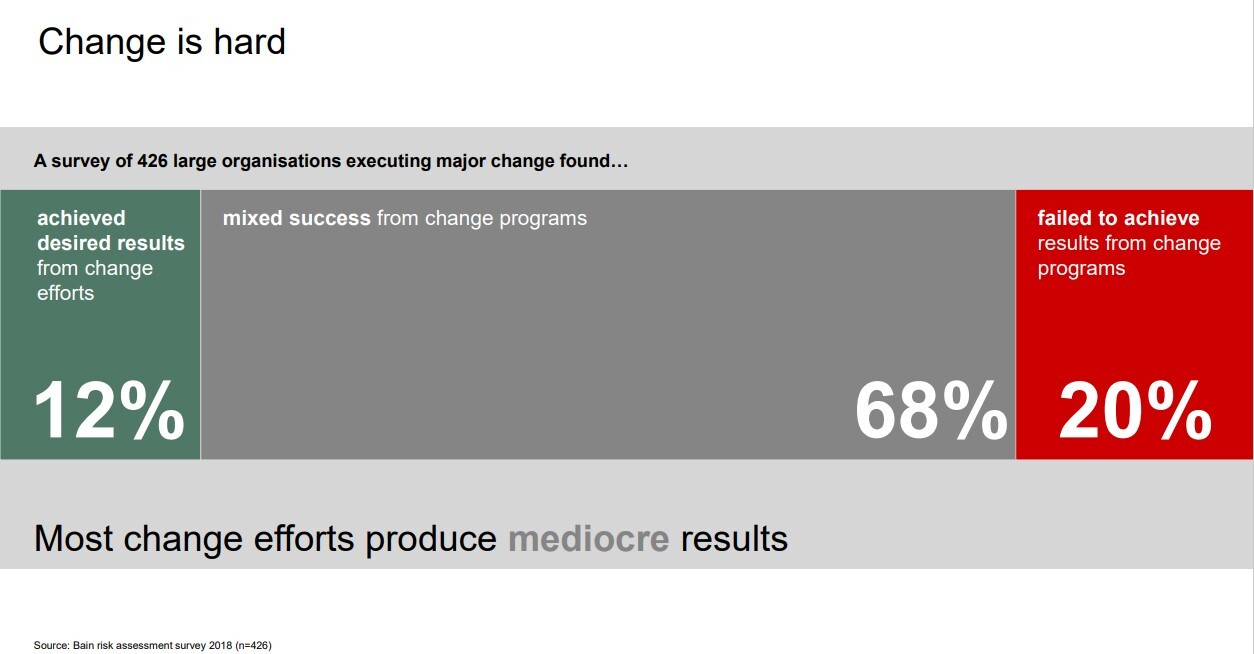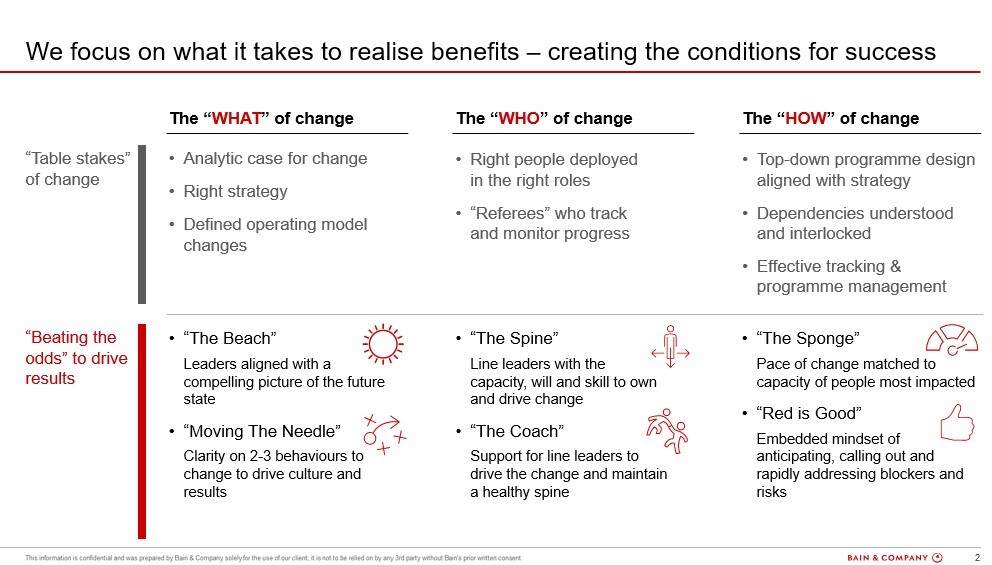Good intent, embodied in a new strategy or in the design of a new operating model, will take you only so far. To realise the full benefit, mindsets and behaviours—how people think and act every day—need to change. Buying gym membership doesn’t make you fit; the habit of exercise does. In the corporate world only 12% of change initiatives achieve what they set out to accomplish, and 20% fail by a wide margin, capturing <50% of the targeted value. Results in the public sector are no better -
an IfG report found 35% of GMPPs are “unfeasible” or “in doubt”.
The disturbing implication: over time, too many organisations unwittingly wind up accepting mediocre performance – at best. As Whitehall gears up for the next wave of change, getting better at making change happen is critical.
Change is hard, particularly in Government where, in spite of recent improvements, many Senior Civil Servants have limited operational or delivery experience. Even in the private sector leaders often have blind spots that can fatally undermine a programme. The most common? The lack of a consistent, aligned vision across the organisation of what is trying to be achieved; line leadership not prioritising change or resisting cross-cutting change “not invented here”; conflicting initiatives; and different parts of the organisation being asked to make too many changes with insufficient attention given to specific leadership and frontline behaviours needed to make change stick.

In successful programmes, leaders anticipate and overcome these blind spots. When we talk to senior leaders about how to drive successful change we ask three simple questions: the “what, who and how.”
The What
Clear strategy is critical, but change most often fails in the implementation. It is the behavioural dimension that organisations tend to neglect. To motivate large-scale organisational change, leaders should ask, “What is our beach?” and “What will move our needle?”
Our beach? When planning a vacation, you get excited by imagining yourself on the beach, not by reading an itinerary. Yet when embarking on a programme, leaders often take more care in developing and communicating the details of the journey than a compelling vision of the destination. Effective change requires a picture of what we’re trying to achieve, leaders who can inspire people, and providing those involved in the change with the internal compass to align their subsequent behaviours, decisions and actions.
But the beach alone isn’t enough to change behaviours. Successful programmes remember that organisations don’t change, people do. Only very few behaviours produce the lion’s share of results. These behaviours must be concrete and cover “moments of truth” relevant to the front line: how an agent handles a customer call, or how a supervisor deals with a politically sensitive incident. Generic statements like “We will be more customer centric” are unactionable. Leaders must work out what exactly frontline employees and management need to do differently in those moments, and how to reinforce these behaviours. Research shows overwhelmingly that reinforcement in the moment is critical for sustaining new behaviours. At HMRC, we helped technology leaders align on five values and behaviours critical to changing the ethos of the organisation. These were communicated in town halls and cascaded by leaders at all levels, then reinforced in moments of truth. A system of measures and feedback was put in place to track and celebrate progress.
The Who
Who makes change happen? Whilst project teams are essential, they can often become disconnected from the front line that makes the actual change. To remedy this, it’s essential to identify who on the front line is most affected by the change, and how the organisation can support them. This raises two questions: “Who is our spine?” and “Who is our coach?”
Responsibility for delivering results rests with thousands of line employees and their supervisors, it can be done purely by a programme office, however large. So it’s critical to identify the people who will need to work differently. And who has the greatest influence on them? Most commonly their direct supervisor. Change efforts depend on a strong “sponsorship spine”: real leaders who can put the change efforts in the context of their teams’ day-to-day job. This can make change happen in even the toughest environments. Gold Fields, a South African miner, had to stabilise declining production as its mines neared the end of their lives by instilling higher-quality ways of working. They turned to the sponsorship spine, establishing a monthly rhythm of training that cascaded through the mine hierarchy to inspire 30,000 employees working 3km underground. This matched the pace of change with each mine’s capacity to adopt new ideas, and the ideas took hold because they were promoted by experienced mine operatives who had credibility with their teams.
But even great line leaders may struggle to manage change. This underscores the need for effective coaching. An enhanced programme office—what we call a Results Delivery® office (RDO) can play this role. The RDO serves as the custodian of the overall programme, ensuring it realizes the desired outcomes. It can assess risk, monitor progress against goals and put in place the necessary interventions to ensure success. The RDO should also provide coaching to the spine. Where necessary this can take the form of “tough love” measures, including giving feedback and advice to line leaders or recommending changes to the team where truly necessary.
The How
The pace and scale of a change programme cannot exceed colleagues’ capacity to handle it along with their other responsibilities. So ask “How much more can our sponge absorb?”
An organisation’s capacity to manage change can easily be overwhelmed. What might seem from the top to be a logical sequence of initiatives can feel very different to someone on the front line being asked to engage with several initiatives at once while also carrying out business as usual. Like a sponge soaking up water, individuals can absorb only so much; adding new initiatives can exhaust or demoralize employees. The way to prevent this is to identify the people most affected by a change and chronicle what the company has asked them to do outside of their normal work. By mapping these activities, you can anticipate when people will get stretched too thin and then actively stop or delay lower-priority initiatives.

Making change happen
Leaders steeped in change know that basic PMOs don’t work. Too often they spend their time “colouring in” – asking programmes about their status is and consolidating the answers. Results Delivery Offices, by contrast, truly understand progress, quizzing and coaching PMs/PDs, re-evaluating whether programmes are on track to deliver objectives, and supporting or intervening when required. An RDO maintains a “red is good” posture, acknowledging individual risks that crop up so that they can be resolved early.
Subash Viroomal is a partner based in Bain & Company’s London Office. He is a leader in the firm’s Public Sector & Government practice and has extensive experience making change happen across Whitehall.
To find out more about how Bain & Company can support you, visit www.bain.com/change-power